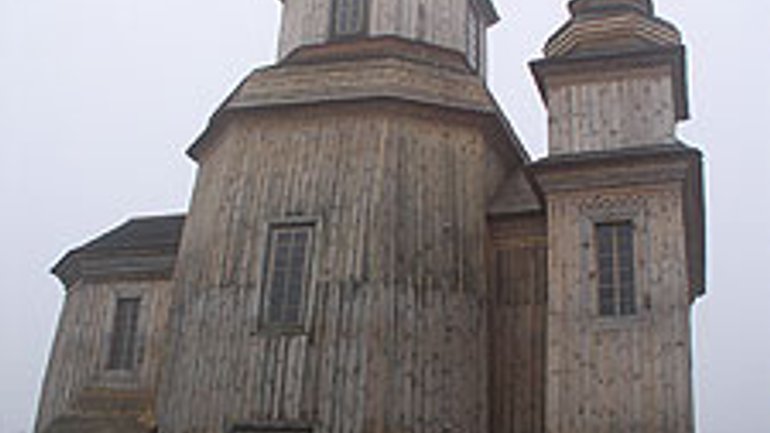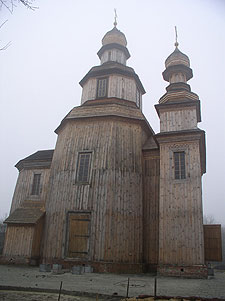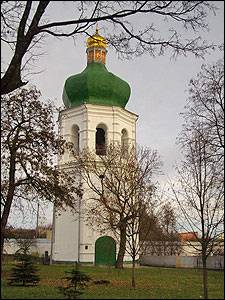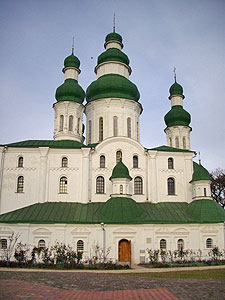Vii’s Churches of the Chernihiv Region

Ukrainian churches have often been filmed not just as decorations, but also as historical monuments – like peculiar dead characters. On more than one occasion, their histories merged with film script legends, which afterwards stuck and became alluring for tourists and truth-seekers indeed. In this article, Olena TERESHCHENKO presents the churches in which were Vii was filmed – their legends and their real histories.
A cockcrow was heard. Frightened spirits rushed to windows and doors in order to fly out more quickly, but far from it: they remained there, stuck in doors and windows. The church accreted with a forest, roots, weeds, wild blackthorn; and nobody will find a road to it…”
M. Gogol, Vii
A damnation of the St. George church
 Gogol’s story about the seminarian Khoma Brut, who was destroyed in a church by evil spirits, sparked the imaginations of many generations of readers. The horrific story even inspired the Soviet cinematographers to shoot the Soviet Union’s first home horror film. Filming took place in a town called Sedniv, in the 17th century St. George’s Church. Today, people call it “Vii’s church.” After an awful fire, the church was neglected for quite some time and people still say that the evil lurks there.
Gogol’s story about the seminarian Khoma Brut, who was destroyed in a church by evil spirits, sparked the imaginations of many generations of readers. The horrific story even inspired the Soviet cinematographers to shoot the Soviet Union’s first home horror film. Filming took place in a town called Sedniv, in the 17th century St. George’s Church. Today, people call it “Vii’s church.” After an awful fire, the church was neglected for quite some time and people still say that the evil lurks there.
The role of the witch in Vii was played by the famous Natalya Varlei. One of the most striking and frightful episodes in the movie is the flight of a dead witch in a coffin under a cupola of the church. It is a miracle that the actress didn’t die in the filming of this episode. She once divulged in an interview that while standing in the coffin, she suddenly she lost balance and fell from a significant height. Natalya was rescued only thanks to Leonid Kuravlev, who caught her as she was about to hit the floor, displaying acrobatics akin to circus art. Natalya Varlei only broke her leg in the fall, but ominous rumors were spread throughout the country that the actress had died.
After finishing work on the film, a trail of misfortunes followed the actress. She later said that filming Vii was an awful sin; evil never forgives such advances. People say that cinematographers should not use real churches in films – such buildings represent an accumulation of many generations of memory. Who knows what forces can be called forth from the depths of such places. But, as the saying goes: every cloud has its silver lining. Today, the damnation of “Vii’s church” has become the main attraction of the provincial Sednev. For many decades, St. George’s Church was abandoned and almost ruined. It was never restored; something always impeded the process of restoration. Or was it somebody who impeded it?
Today, restoration of St. George’s Church is almost finished and archaeological explorations were conducted near the church. Throughout the process, nothing bad happened and the new restored church does not look ominous at all. Liturgies are yet to be served in the church and no denomination is in a hurry to declare rights to serve in the church. If one believes Nikolai Gogol, evil can destroy a person even in a holy place. Will priests not be afraid that “Vii’s church” is damned?
Vii in a monastery of Yeletsk
There is another place in the region of Chernihiv that was used in the filming of Vii. All sorts of mysticism passed it over, but a sad fate eventually caught up to the Chernihiv monastery of Yeletsk too without all kinds of damnations.
Filming in the monastery of Yeletsk took place in June of 1966. The territory of the monastery was terribly blocked up. Nobody thought about its conservation as a monument. Rather numerous different organizations occupied it: the “Dynamo” society and pharmacy storehouses, a regional academic library, a hostel for members of the Chernihiv philharmonic orchestra.
The cathedral of the Dormition was filmed in a scene in which seminarians are running out a gate after being dismissed for vacation. The cinematographers had to clean up the cathedral so that it would be in more or less proper shape before starting to film. They repaired an old door (which was hanging on one hinge) and painted the cupolas of the church green. Most importantly, they filled up a huge puddle in front of the cathedral. Fences and stiles with crocks and homespun strips of carpet were set. In front of the church, they placed a britzka (though without a horse) and started filming an outing of old men played by Mykola Yakovchenko, Mykola Panasyev and Stepan Shkurat. The latter (and oldest) actor in the cast proved to be a terrible grumbler. Regional ethnographer and bibliographer Ludmyla Studonova remembers a funny incident she witnessed: In one scene, makeup artists purposely dirtied overcoats so that it would appear as if they had already made a lot of versts. Shkurat started to quarrel, saying that he would not put it on and would complain to the producers. Colleagues had already got accustomed to such behavior by that point, so they didn’t really pay special attention to it. Inversely, it was remarkably easy to communicate with Yakovchenko, who constantly told jokes and life stories. Generally speaking, he did not suffer from the big-headedness many “stars” suffer from.
 The cinematographers also wanted to shoot the most horrible scenes between Khoma and the witch in the monastery of Yeletsk. However, this idea was almost immediately rejected as it turned out that the church simply could not accommodate the necessary props. Then a XVIIth century bell tower struck the cinematographs but the interior was almost completely destroyed, neglected; windows were broken and it was very dirty. And amidst the wreckage: a huge bust of Stalin. Formerly, this monument stood across the current home to the historical department of the Chernihiv Pedagogical University. During the era of abolishing the “the cult of the person,” the statue of the former leader must have been stuffed in the monastery bell tower (see photo above).
The cinematographers also wanted to shoot the most horrible scenes between Khoma and the witch in the monastery of Yeletsk. However, this idea was almost immediately rejected as it turned out that the church simply could not accommodate the necessary props. Then a XVIIth century bell tower struck the cinematographs but the interior was almost completely destroyed, neglected; windows were broken and it was very dirty. And amidst the wreckage: a huge bust of Stalin. Formerly, this monument stood across the current home to the historical department of the Chernihiv Pedagogical University. During the era of abolishing the “the cult of the person,” the statue of the former leader must have been stuffed in the monastery bell tower (see photo above).
With the enormous efforts (the bust was huge and very heavy), the monument disposed of. Yet the bell tower did not become “Vii’s church”. It would take a very long time to put the abandoned building in order and the cinematographers decided instead to drive out to Sedniv to film.
But Leonid Kuravlev was in the monastery of Yeletsk and some scenes with Khoma and the witch were filmed there. The nighttime wanderings of the seminarian were filmed near the pharmacy storehouses. There was a huge forest on the territory of the monastery at that time and finding an appropriate place to film would not have been so difficult.
When the crew left for Sedniv, the sad hex of “Vii’s church” went with them, somehow overlooking the monastery of Yeletsk. All remained safe and sound; no nighttime horrors occurred and life went on uneventfully and generally smoothly as always. Perhaps this was because no demonic scenes were filmed in the monastery, just everyday scenes. But then again, maybe even everyday scenes should not be filmed in a real (no less ancient) church. Mysticism is a delicate thing.
Vii’s church in Nizhyn
Inhabitants of Nizhyn can also boast of their own “Vii’s church”. In honesty, the film was not shot there, but according to local lore, it was the church in this town that inspired Nikolai Gogol to write the horrific story about the seminarian and the witch.
 In one of the former suburbs of Nizhyn – Magerky – there is an old church. During Gogol’s time, joyful pagan festivals called “vechornyzi” were held at night and everybody knew that the most beautiful girls lived in Magerky. During one of these parties, Gogol heard a horrible story that came to be the backbone of his future classic:
In one of the former suburbs of Nizhyn – Magerky – there is an old church. During Gogol’s time, joyful pagan festivals called “vechornyzi” were held at night and everybody knew that the most beautiful girls lived in Magerky. During one of these parties, Gogol heard a horrible story that came to be the backbone of his future classic:
Once upon a time, the beautiful daughter of a local aristocrat or colonel died. The body was brought to a church and according to tradition, a young seminarian read prayers over it. When night fell, the boy stopped reading and approached the coffin. Maybe he wanted to see the dead girl or maybe he wanted to remove the valuable ring from her finger. Regardless, the girl suddenly stood up in the coffin and the fated seminarian died at once from a heart attack.
Supplementing this folk legend with elaborately horrific details, Gogol created one of his most mystical works.









